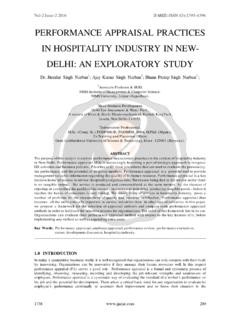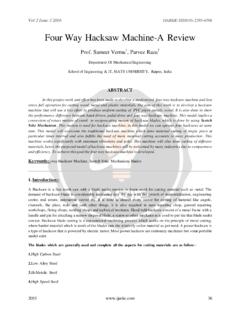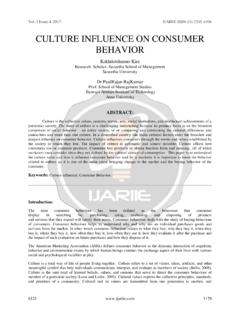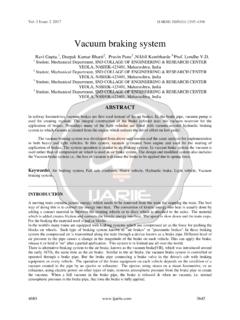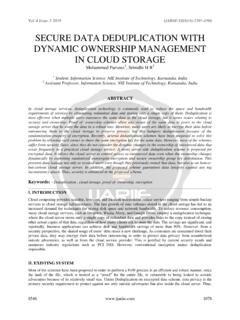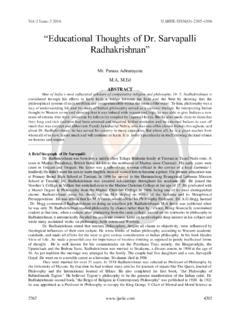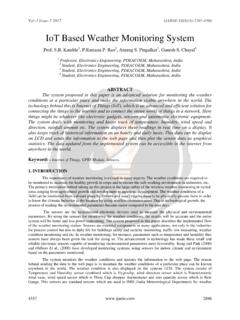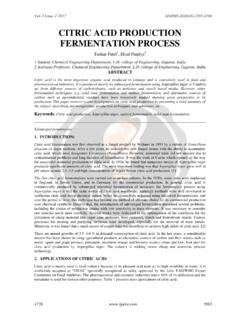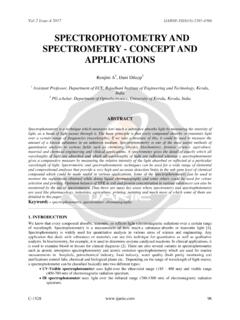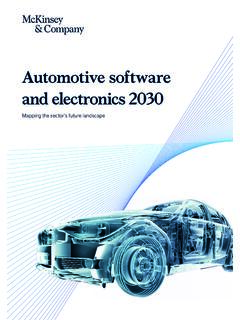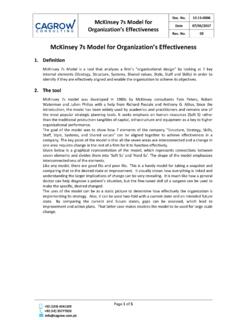Transcription of A case study of application of Mc-Kinsey 7-S framework to ...
1 Vol-4 Issue-3 2018 IJARIIE-ISSN(O)-2395-4396 8395 313 A case study of application of Mc-Kinsey 7-S framework to investigate the effectiveness of new product development and launch strategies 1 Kedarnath Rajeshwar Koyalkar, 2Dr. Sayalee Gankar MBA, PhD Appeared MIT-SOM Abstract In the ever increasing competitive environment of India, the development and launch of new products has become an important competitive tool and it also demands efforts by all departments of organization to give synergetic results. In a crowded marketplace, there is greater need for differentiation, in markets that tend to be stagnant there is pressure to create excitement. The development and launch of new products helps in both situations. In certain industries like the FMCG industry, new product development has become critical to survival.
2 New standards and multi-point competition are pushing FMCG companies to broaden their product lines and introduce new products such as multigrain Noodles, high number of nutrition in health food drink. But as many scholars mentioned, most of the new product fails at there launching stage so it need scientific application to investigate the effectiveness of launch strategy. INTRODUCTION: With a population of over one billion, India is one of the largest economies in the world in terms of purchasing power and increasing consumer spending, next to China. The Indian FMCG industry, with an estimated market size of 2 trillion, accounts for the fourth largest sector in India. In the last decade, the FMCG sector has grown at an average of 11% a year; in the last five years, annual growth accelerated at compounded rate of The sector is characterized by strong presence of global businesses, intense competition between organized and unorganized players, well established distribution network and low operational cost.
3 Availability of key raw materials, cheaper labor costs and presence across the entire value chain gives India a competitive advantage. During 2012, the country witnessed high inflation, muted salary hikes and slowing economic growth, which affected the FMCG sector with companies posting deceleration in volume growth in their quarterly results. However, the trend seen in 2012 has accelerated in 2013 as growth came from rural dwellers that are expected to see further rise in their disposable incomes. How do you go about analyzing how well your organization is positioned to achieve new product development and launch strategies This is a question that has been asked for many years, and there are many different answers. Some approaches look at internal factors, others look at external ones, some combine these perspectives, and others look for congruence between various aspects of the organization being studied.
4 Ultimately, the issue comes down to which factors to study . While some models of organizational effectiveness go in and out of fashion, one that has persisted is the mckinsey 7S framework . Developed in the early 1980s by Tom Peters and Robert Waterman, two consultants working at the mckinsey & Company consulting firm, the basic premise of the model is that there are seven internal aspects of an organization that need to be aligned if it is to be successful. The 7S model can be used in a wide variety of situations where an alignment perspective is useful, for example, to help you Improve the performance of a company, Examine the likely effects of future changes within a company, Align departments and processes during a merger or acquisition, Determine how best to implement a proposed strategy, how to go about new product development and Launch The Seven Elements of the mckinsey 7S model involves seven interdependent factors.
5 Vol-4 Issue-3 2018 IJARIIE-ISSN(O)-2395-4396 8395 314 Let's look at each of the elements specifically: Strategy: the plan devised to maintain and build competitive advantage over the competition. Structure: the way the organization is structured and who reports to whom. Systems: the daily activities and procedures that staff members engage in to get the job done. Shared Values: called "super ordinate goals" when the model was first developed, these are the core values of the company that are evidenced in the corporate culture and the general work ethic. Style: the style of leadership adopted. Staff: the employees and their general capabilities. Skills: the actual skills and competencies of the employees working for the company Objective of study :- 1. To study application of mckinsey 7-S framework to ensure profitability at new product development and launch strategies in the FMCG sector.
6 Mainframe:- Research Methodology Quantitative Research is used for examining the relationship between mckinsey 7s framework and new product development and analysis. Quantitative research is a systematic, objective oriented methodology that mainly involves numerical data analysis using statistical methods (Thomas, 2003; Creswell, 2003). It aims at determining or quantifying relationship between independent variables and dependent variables or outcome variables (Hopkins, 2000). Hence, quantitative research design is chosen as appropriate for doing this research. Vol-4 Issue-3 2018 IJARIIE-ISSN(O)-2395-4396 8395 315 Research Question:- 1. application of mckinsey 7s framework has positive impact on new product development and launch strategy. 2. New product development and launch strategy has positive impact on performance The hypothetical model consists of nine variables (Strategy, Structure and Systems, Shared Values, Skills, Staff and Style, New product development and launch and performance).
7 Each variable is measured by multiple item scale, each item is measured using five point scale (1= strongly disagree, 2= Disagree, 3= neither agree nor disagree, 4= Agree, 5= strongly agree). All latent variables are converted into summated for the sake of convenience of data analysis. A description of all the latent constructs and their measured indicators is as follows: Path Analysis:- The researchers hypothetical model is validated using path analysis. Path analysis is minor version of structure equation model , Path analysis is an advance statistical technique used to study relationship between several variables simultaneously. Research Question:- 1. Whether mckinsey 7s are the positive predictors of new product development and strategy. 2. Whether new product development launch strategy has positive impact on performance. model evaluation:- Five fit indices (CMIN/DF, CFI, GFI, PNFI and RMR) FIT INDICES OBSERVED CRITERIA FOR ACCEPTABLE FIT RESULT CMIN/DF Less than 5 Marginally missed CFI More than for good fit Acceptable fit GFI More than Accepted fit RMR Less than for adequate fit, between and less than Acceptable fit All the four fit indices are good fit between the hypothetical model and sample data.
8 Vol-4 Issue-3 2018 IJARIIE-ISSN(O)-2395-4396 8395 316 Assessing the significance path- Variable Estimate Variable Standardized regression weights P value Result NewProdLaunchDevStr <--- Strategy NS NewProdLaunchDevStr <--- Structure NS NewProdLaunchDevStr <--- System ** Sig NewProdLaunchDevStr <--- ShareValue Sig NewProdLaunchDevStr <--- Style ** Sig NewProdLaunchDevStr <--- Skills ** Sig NewProdLaunchDevStr <--- Staff ** Sig Performance <--- NewProdLaunchDevStr ** Sig Performance <--- Strategy Sig Performance <--- Structure ** Sig Performance <--- System Sig NS = not significant, sig: significant Above table reveal that the path between strategy and new product development and launch, structure and new product development and launch are not significant rest all the paths are significant, hence it is concluded that system, shared value, style, skill, staff are positive predictors of new product development and launch.
9 New product development and launch is positive predictor of performance. Structure, System and strategy are positive predictors of performance. References The main source of academic work on the 7S model has to be the writings of Waterman et al. (1980; 1982), and Pascale and Athos (1981) who came up with the idea and applied it to analyze over 70 large organizations. Since then, it has been used by hundreds of organizations and academics for analytical purposes. Many such case studies can be obtained from the academic journals and the books written on the topic. A few case studies, for example the analyses of Coca-Cola and energy giant Centrica (Owner of British Gas), are also available at this website. Ansoff,I.(1965) Corporate Strategy, McGraw-Hill, London Boyle, S. (2007) "Impact of Changes in Organizational Structure on Selected Key Performance Indicators for Cultural Organizations", International Journal of Cultural Policy, Vol.
10 13 (3), 334. Lynch, R. (2005) "Corporate Strategy" (4th edition), Prentice Hall, UK. Peters, T. and Waterman, R. (1982) "In Search of Excellence", New York, London: Harper & Row Vol-4 Issue-3 2018 IJARIIE-ISSN(O)-2395-4396 8395 317 Price, A. and Chahal, K. (2006) "A Strategic framework for Change Management", Construction Management and Economics, Vol. 24 (3), 251 A Brief History of the 7-S (" mckinsey 7-S") model - Tom Peters' blog post describing the origins of the model . Structure is Not Organization -Business Horizons, June 1980.
